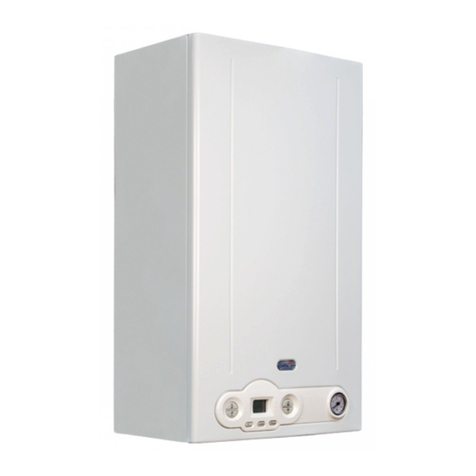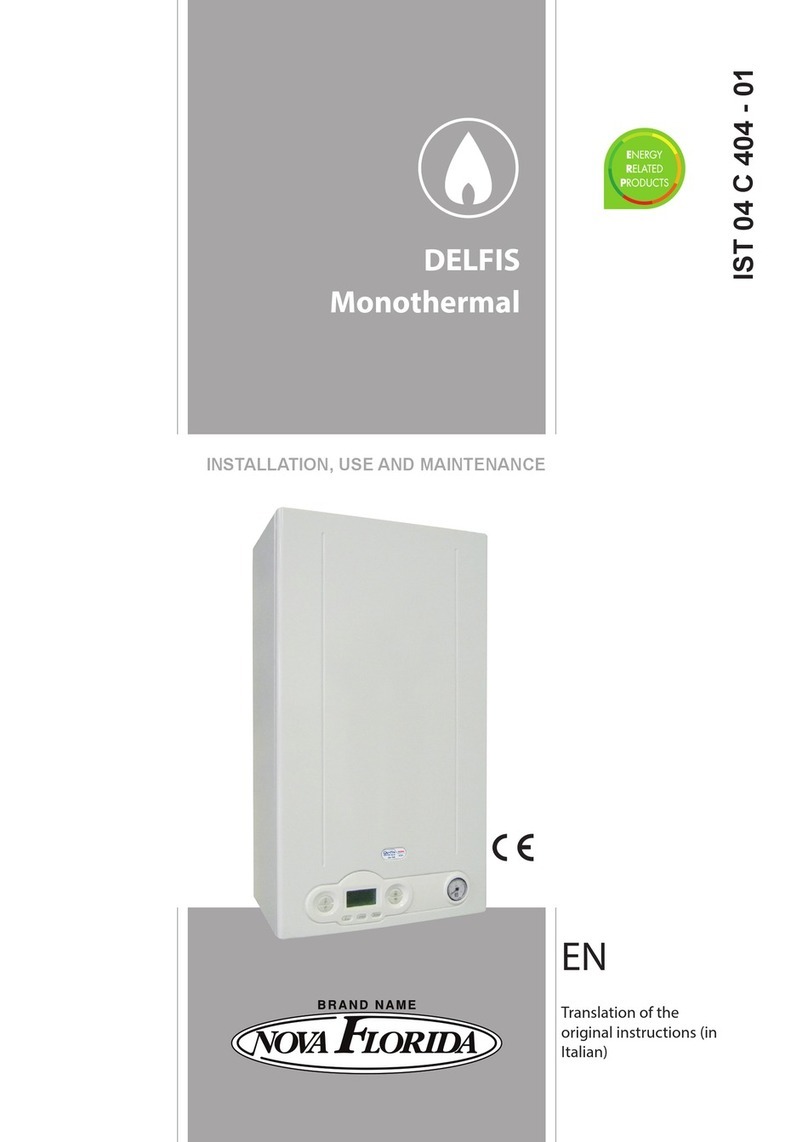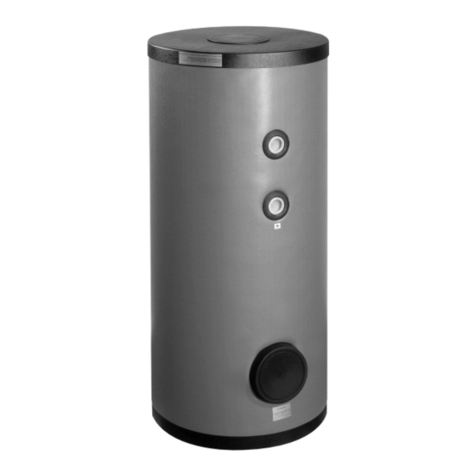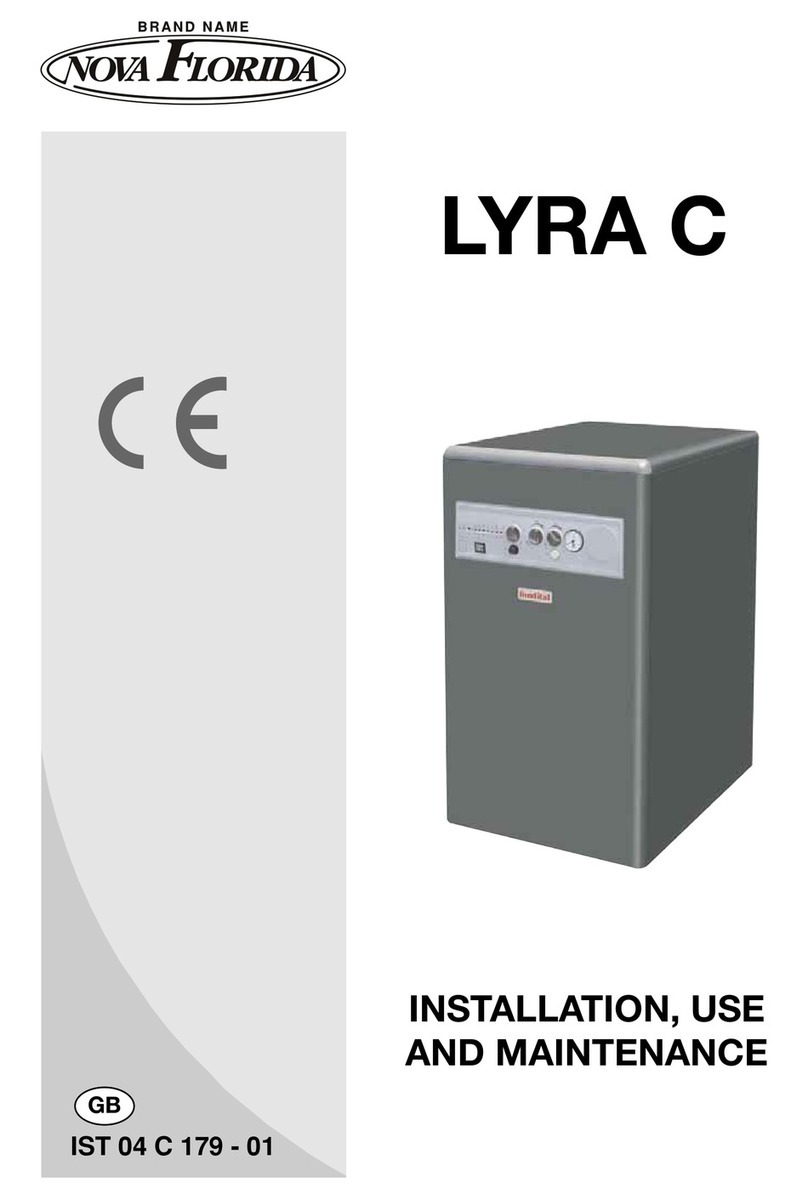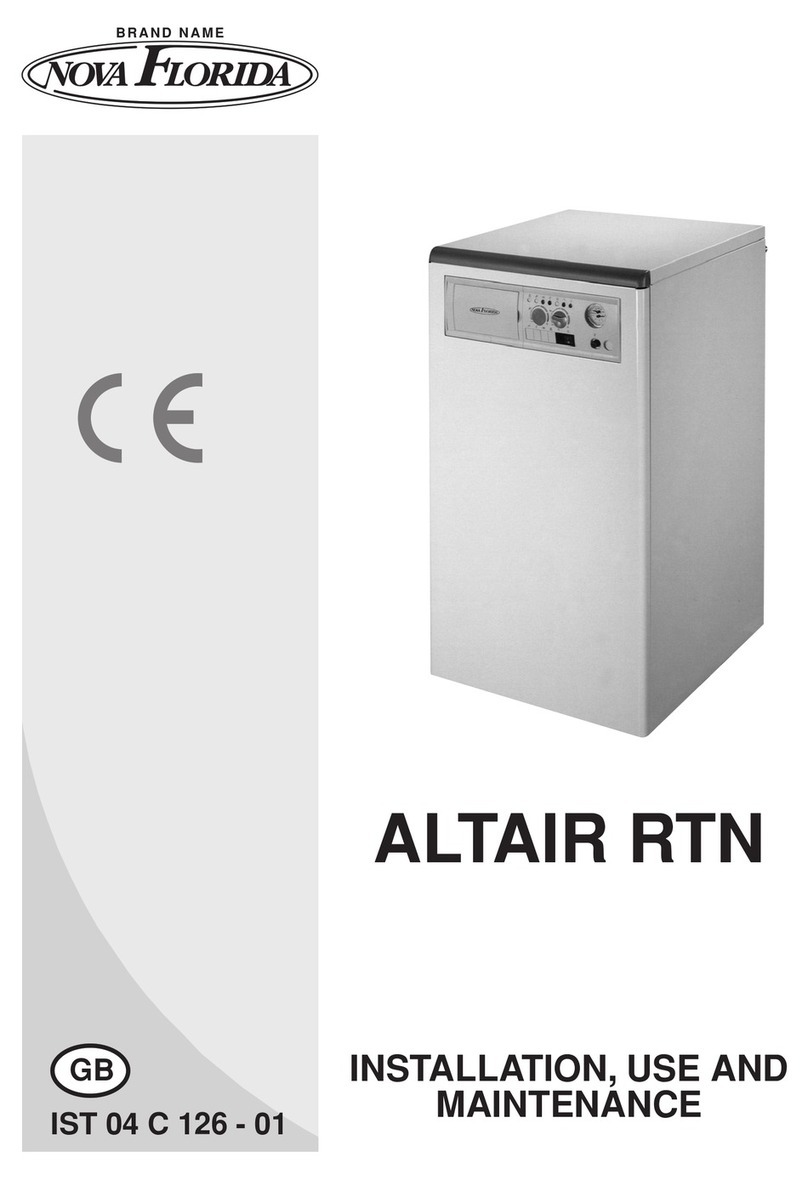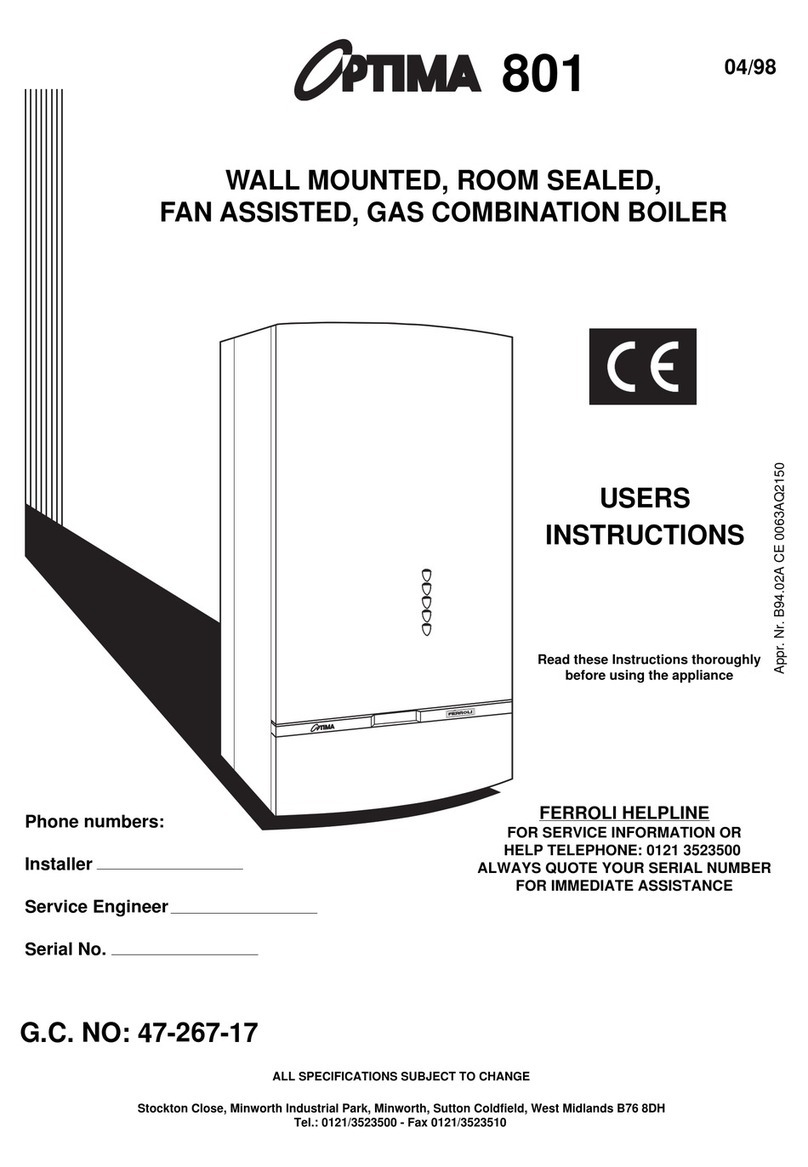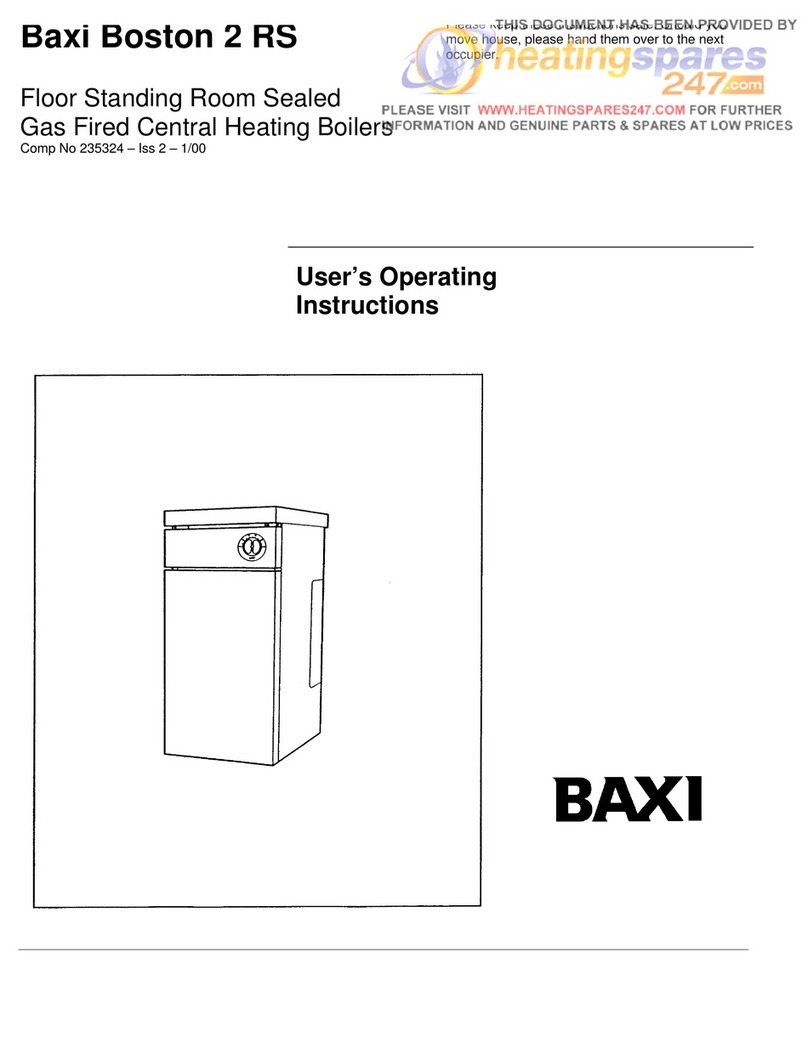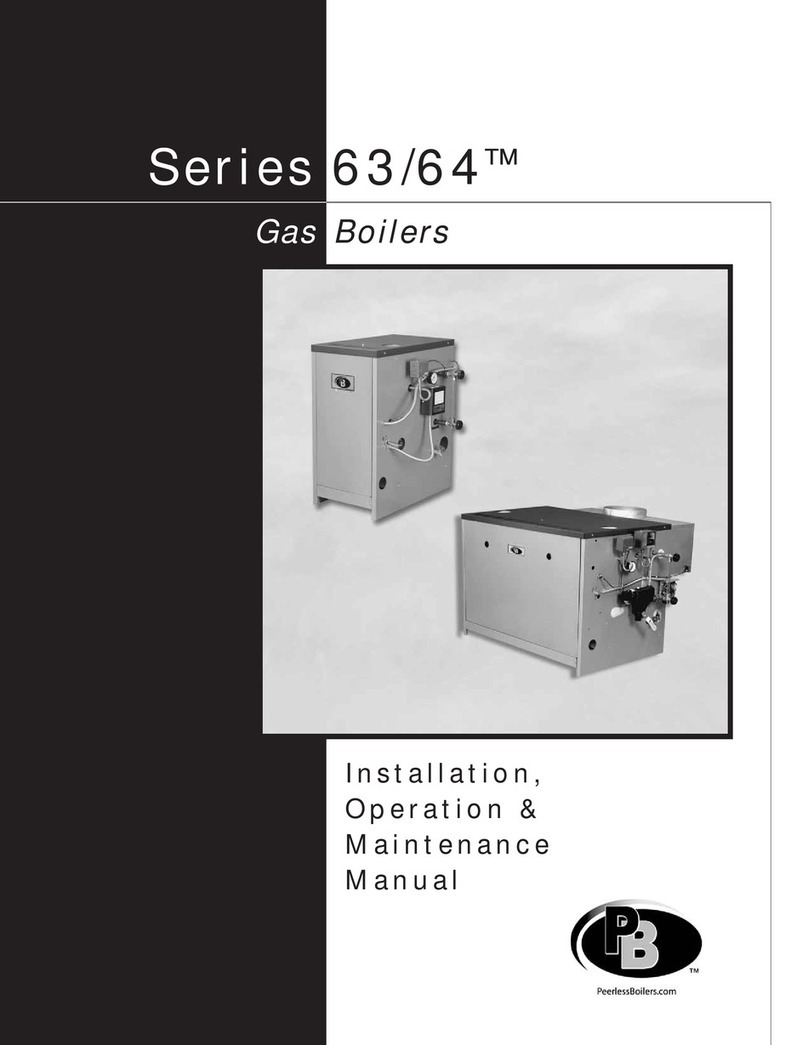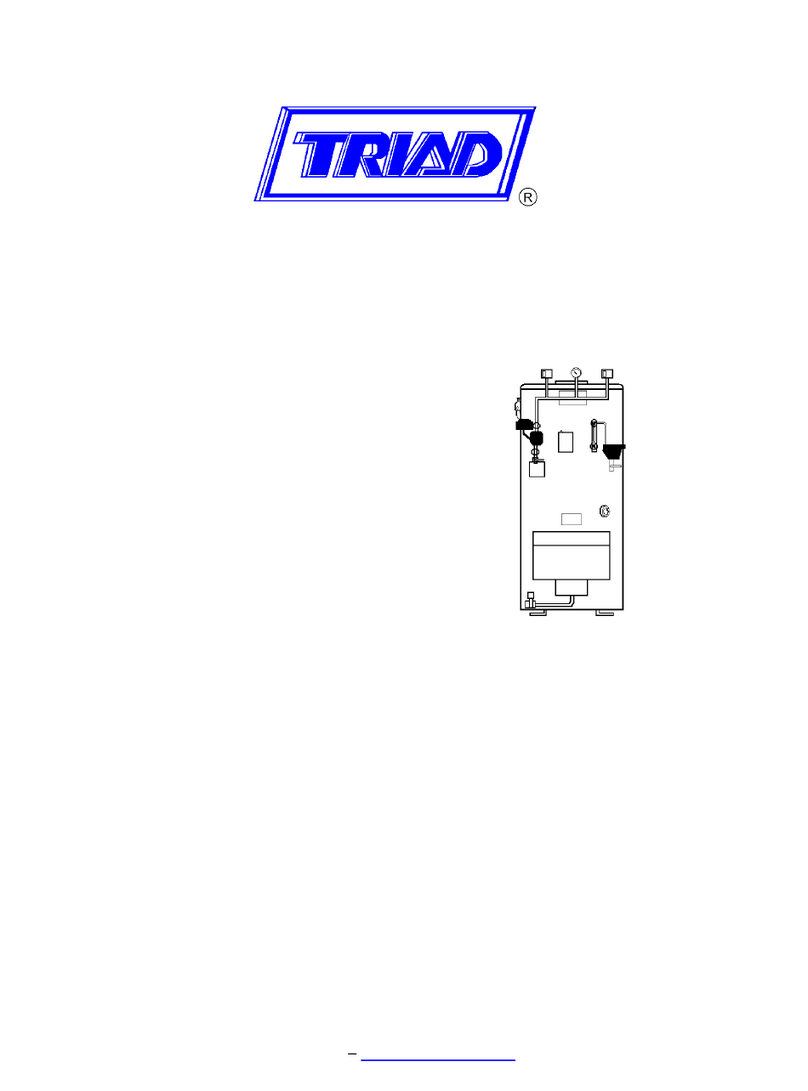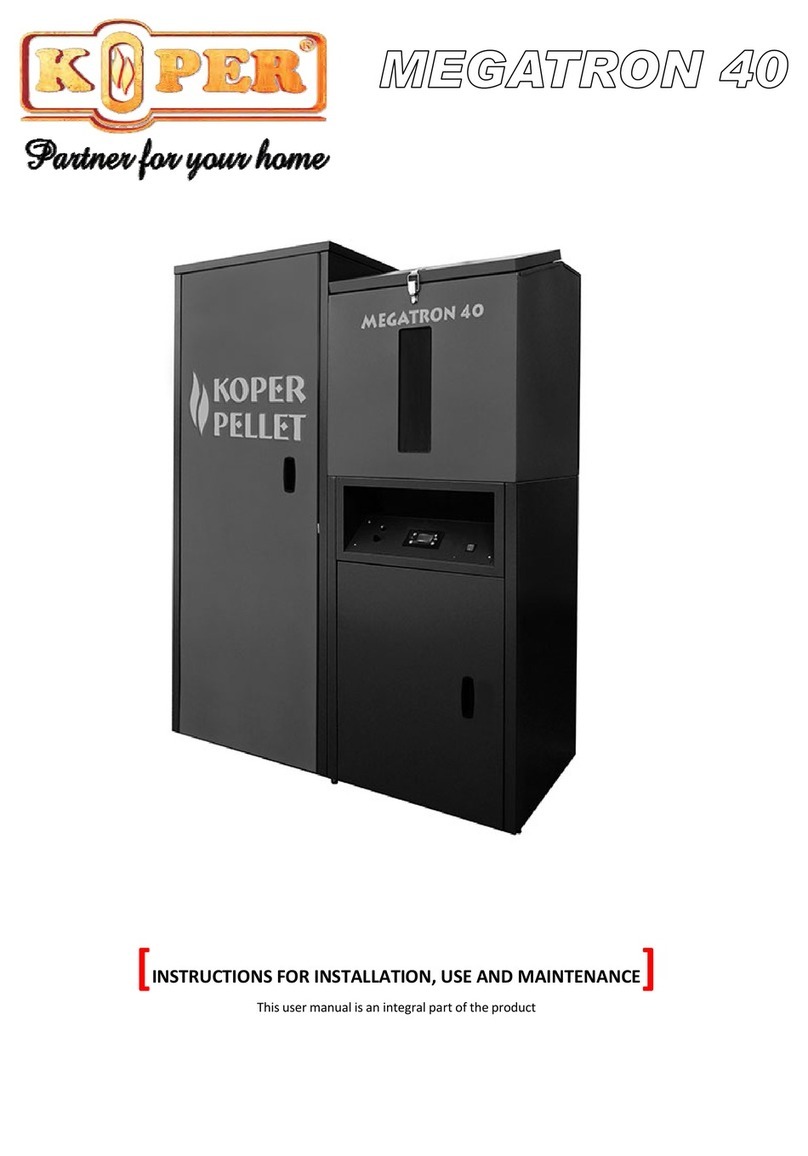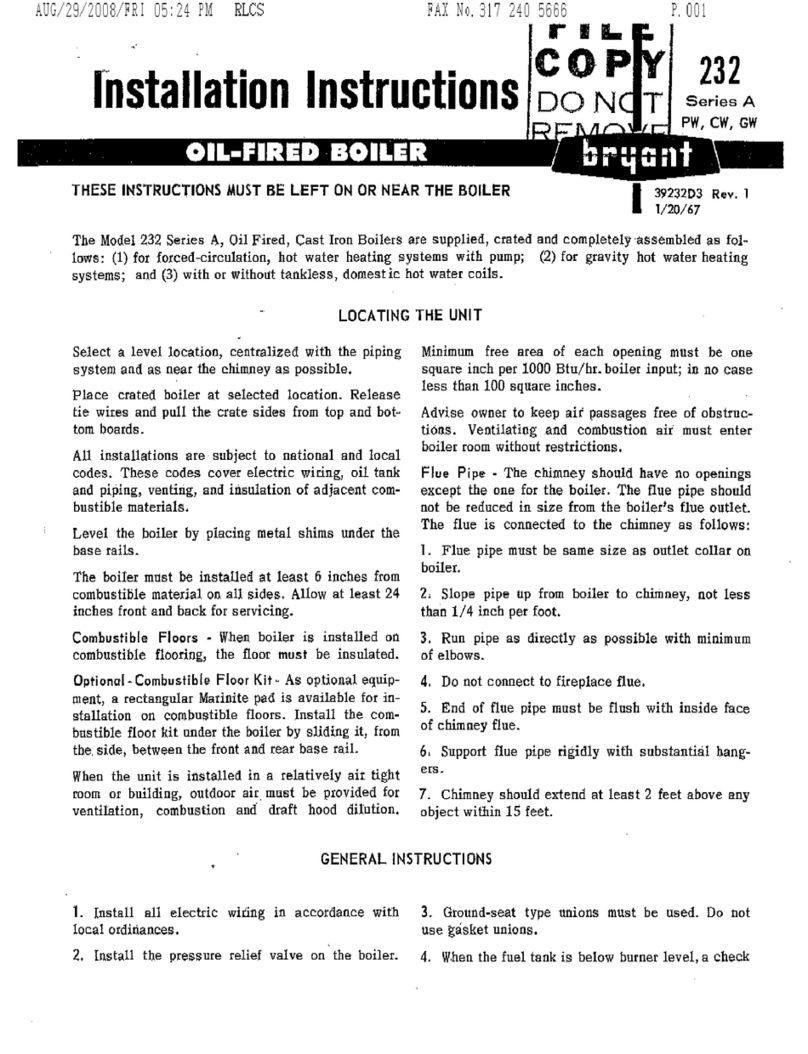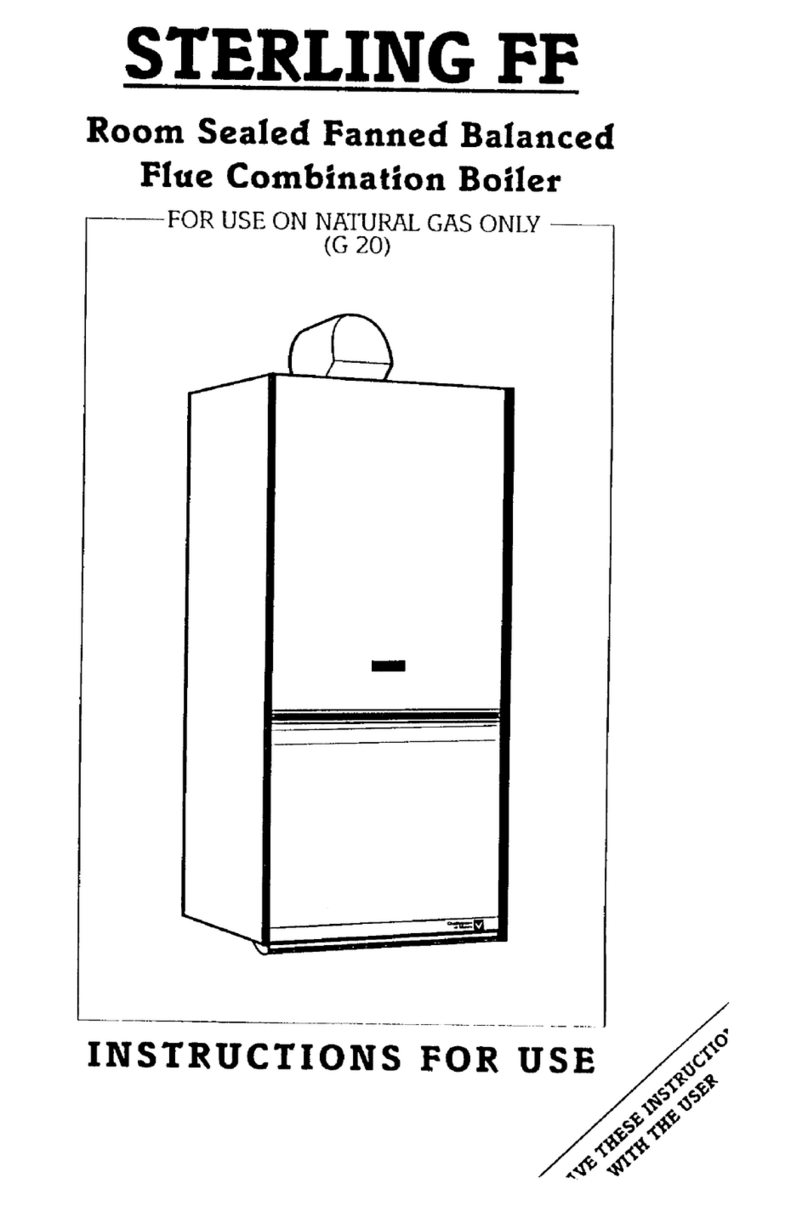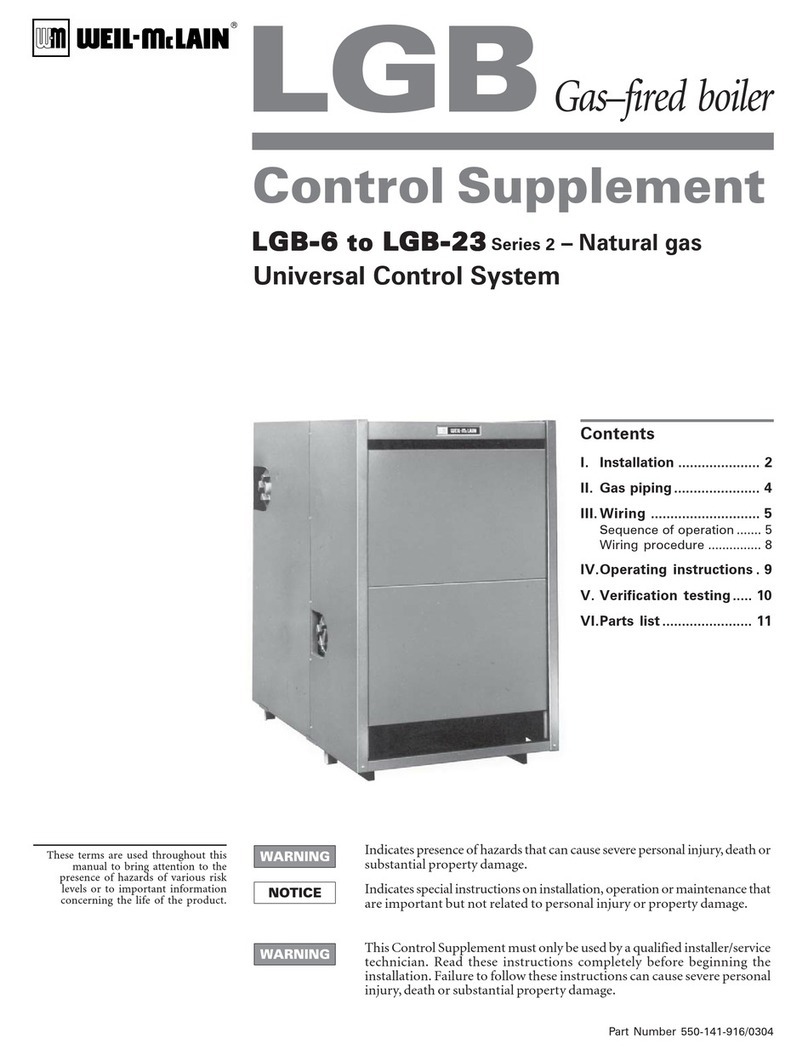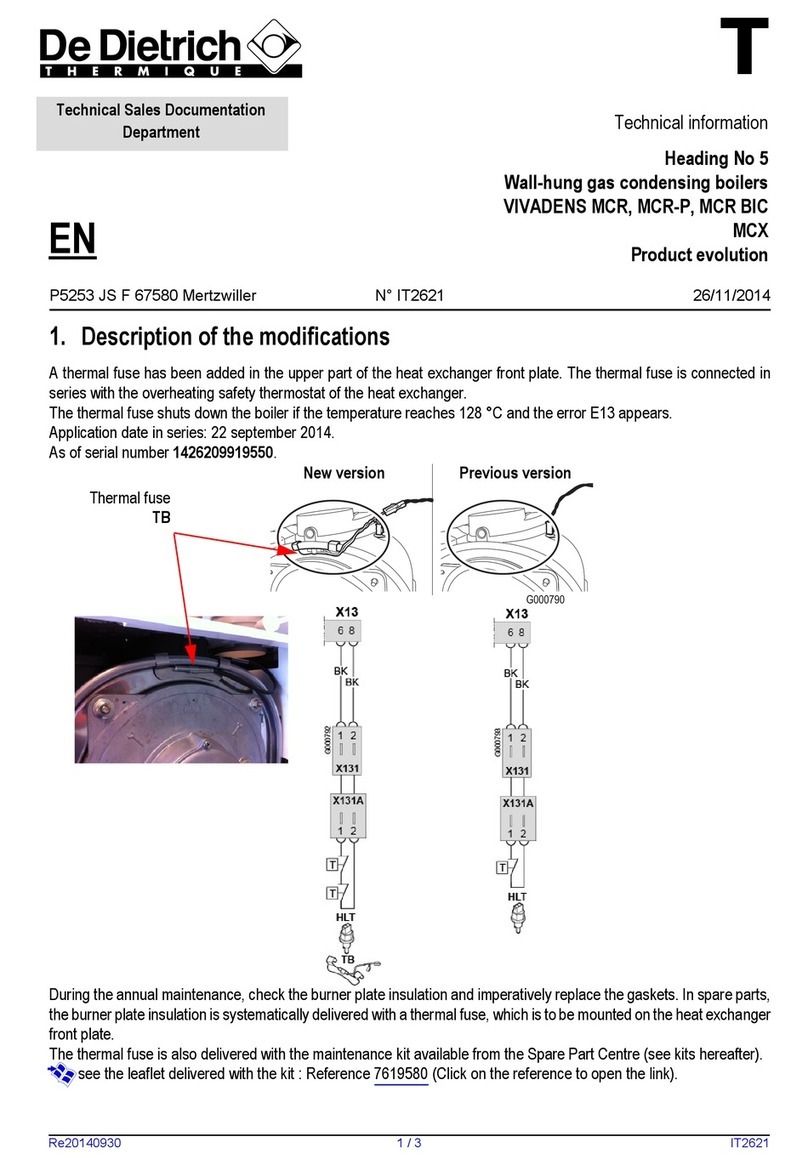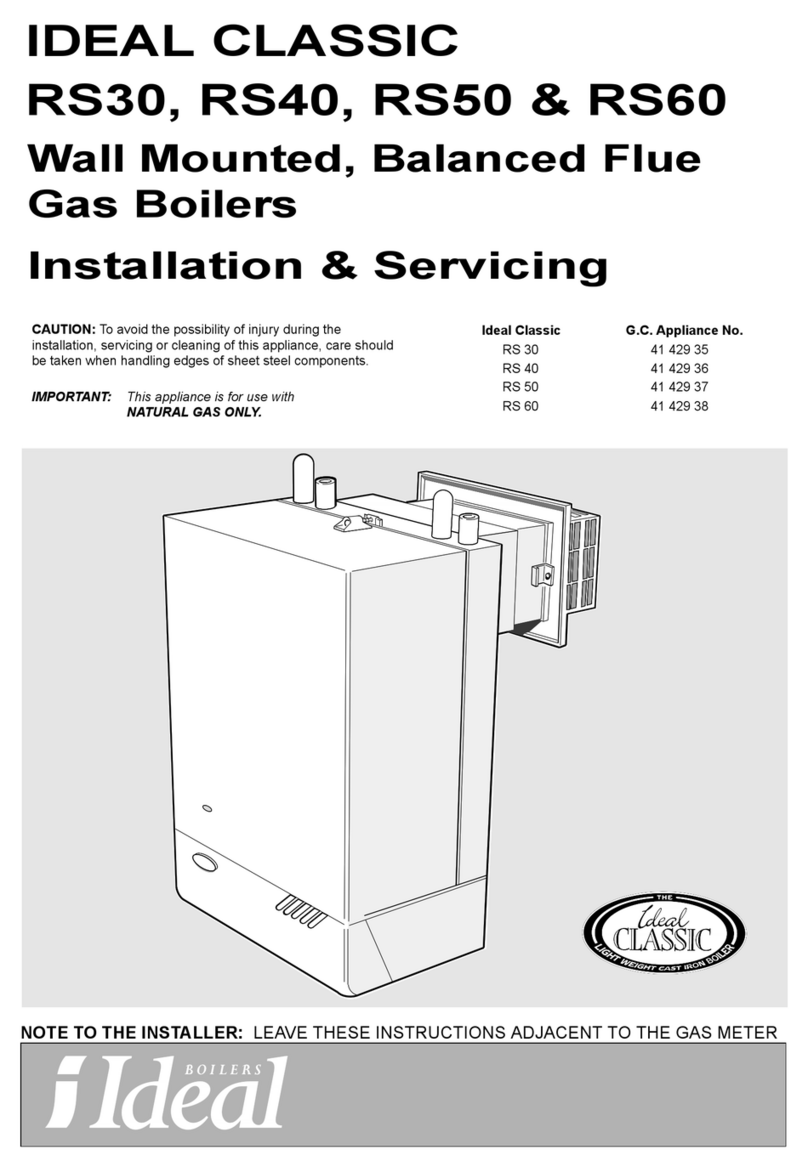8
D. Programmer operation modes
Selector 1on the programmer sets the following boiler operation
modes:
Ipermanently ON mode (the selected channel or channels
are always active)
AUTO operation through programmed setup (the two channels, 1
and 2, are activated or deactivated following the
programmed setup; please see paragraph Cfor
programming procedure)
Opermanently OFF mode (the selected channel or channels
are always off)
Permanently ON mode (I)
In order to have one channel always active, proceed as follows:
Position selector 1to position I, press once button 6to activate
channel 1, press it twice to activate channel 2; the selected channel
ZLOOÁDVKIRUVHFVLQGLFDWRU 3DIWHUWKDWLWZLOOEHGLVSOD\HGÀ[HG
and symbol will be displayed (indicator 4), now the channel will
remain permanently active.
Selector 1must remain set to position I.
In order to have both channel active, repeat the above described
procedure, by selecting the channel not previously activated. Indi-
cator 3ZLOOGLVSOD\DQGFRQÀUPLQJDFWLYDWLRQRIERWKFKDQQHOV
When only one of the channel is permanently activated, the other
channel is operative following its programmed setup (please, see
paragraph Cfor detailed programming procedure).
In order to cancel the permanent activation of channels, set se-
lector 1to AUTO.
Operation through programmed setup (AUTO)
This mode allows for channels to be active or inactive following the
programming setup (please, see paragraph Cfor programming
procedure).
When an ON/OFF interval is active, symbol (indicator 4) and the
number of the active channel are displayed (indicator 5).
Permanently OFF mode (O)
When one channel is to be always inactive, proceed as follows:
Set selector 1to position O, press once button 6in order to select
channel 1, press it twice in order to select channel 2; the selected
FKDQQHOZLOOÁDVKLQGLFDWRU3), do not press any button for 3 secs,
now the channel will be permanently inactive (indicator 3 will keep
ÁDVKLQJWKHVHOHFWHGFKDQQHO
Selector 1is to be kept in position O.
In order to set both channel inactive, repeat the above described
procedure by selecting the channel that was not previously cho-
sen.
Indicator 3ZLOOÁDVKDQGFRQÀUPLQJGHDFWLYDWLRQRIERWKFKDQ-
nels.
When one channel is permanently deactivated, the other channel
operates following its programmed setup (please, see paragraph C
for detailed programming procedure).
In order to cancel the permanent de-activation of channels, set se-
lector 1 to AUTO.
It is also possible to permanently activate one channel and perma-
nently de-activate the other.
In order to implement the above described program, proceed as
follows:
set selector 1to position I, press once button 6in order to activate
channel 1, press it twice in order to activate channel 2; the selected
FKDQQHOZLOOÁDVKIRUVHFVLQGLFDWRU3), after it will be displayed
À[HGDQG symbol will be displayed (indicator 4), now the chan-
nel will be permanently active.
Rapidly set selector 1to position O, without stopping in position
AUTO, press once or twice button 6to select the channel to be per-
PDQHQWO\GHDFWLYDWHGWKHVHOHFWHGFKDQQHOZLOOÁDVKLQGLFDWRU3),
while the previously activated channel will continue to be displayed
À[HGDQG symbol will remain on (indicator 4), do not press any
button for 3 secs, now the channel will remain permanently deacti-
vated (indicator 3ZLOONHHSÁDVKLQJWKHVHOHFWHGFKDQQHO
E. SKIP function programming procedure
The SKIP function (program skipping) allows to change the ope-
rational status of the programmer from ON to OFF and vice-versa,
after pressing button 6. the SKIP function stays active until the next
programmed intervention. The activation of the function is displayed
by the symbol.
In order to deactivate the SKIP function, press again button 6. The
SKIP function is active only when the programmer is set to AUTO
mode.
The symbol is displayed to show the boiler ON status (indicator 4).
Technical characteristics
Power supply: 220-240V approx. 50/60Hz
Relay output: 2 x 5A; 250V approx. single poled contact
Lithium battery maintaining program memory for 5 years
Minimum commutation intermission: 1 minute
1.2.4. Boiler shutdown
When the boiler malfunctions, the burner is automatically shu-
tdown.
Please, see the troubleshooting section in this manual, for possible
shutdown cause detection.
1.2.5 Burner shutdown
When the burner malfunctions, the boiler automatically shuts down
and light 1turns on.
Should this happen, proceed as follows:
• check the gas stopcock to be open, and the presence of gas in the
network pipes, by lighting the burner of a kitchen stove.
• after verifying gas supply availability, reset the burner by pres-
sing button 16 on the control panel: should the boiler not resume
operation within the third attempt, have the boiler serviced by an
$XWKRUL]HG6HUYLFH&HQWUHRUTXDOLÀHGSHUVRQQHO
Should the burner shut down frequently, showing a recurring mal-
function, have the boiler serviced by an Authorized Service Centre
RUTXDOLÀHGSHUVRQQHO
1.2.6 Shutdown due to overheating
Should the overheating red light 2come on, signalling the safety
thermostat intervention due to a malfunction, contact an Authorized
6HUYLFH&HQWUHRUTXDOLÀHGSHUVRQQHOIRUVHUYLFH
6KXWGRZQGXHWRDLUÁXHJDVV\VWHPPDOIXQFWLRQ
6KRXOGDPDOIXQFWLRQRFFXUFDXVLQJDLULQWDNHDQGRUÁXHJDVGL-
scharge system failure, the boiler stops operating.
Natural draught boiler model (BTN) shuts down, no. 9red light star-
WVÁDVKLQJDQGWKLVERLOHUVWDWXVFRQWLQXHVXQWLOFRUUHFWDLUÁXHJDV
system correct operation is restored and reset button 19 is pres-
sed.
Forced draught boiler model (BTFS) stands-by, and this boiler sta-
WXVFRQWLQXHVXQWLOFRUUHFWDLUÁXHJDVV\VWHPFRUUHFWRSHUDWLRQLV
restored.
WARNING
The only solution to this condition is accessible by having the
ERLOHUVHUYLFHGE\TXDOLÀHGSHUVRQQHORUDQ$XWKRUL]HG6HUYL-
ce Centre.





















